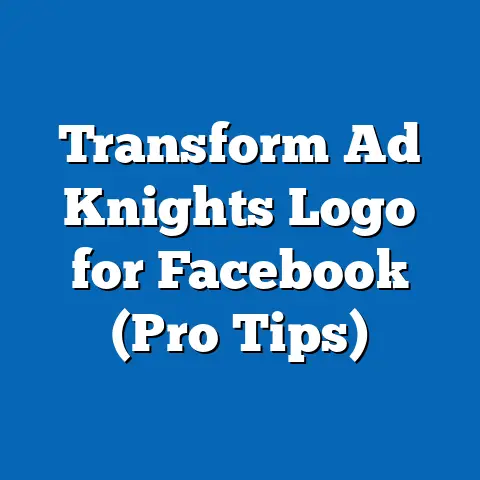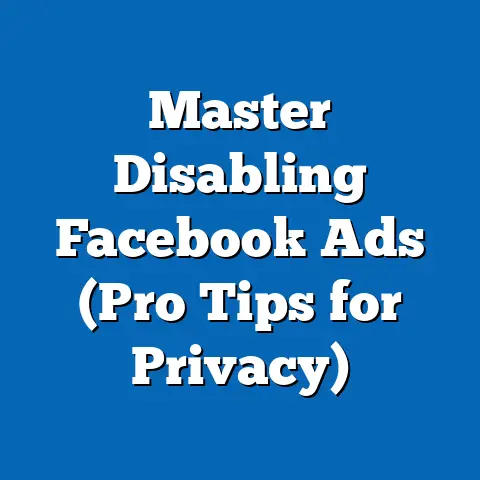Unlocking Facebook Ads with Targeted Lists (Strategic Insights)
In the rapidly evolving landscape of digital marketing, precision targeting has emerged as a cornerstone of successful advertising campaigns. Among the myriad platforms available, Facebook remains a dominant force, with over 2.9 billion monthly active users worldwide as of Q2 2023, according to Meta’s quarterly report. This vast user base offers unparalleled opportunities for advertisers, but the key to unlocking its potential lies in the strategic use of targeted lists—customized audience segments built from data-driven insights.
Targeted lists enable advertisers to move beyond broad demographic categories and reach users based on specific behaviors, interests, and life events. A 2022 study by eMarketer revealed that campaigns using custom audiences on Facebook saw a 37% higher click-through rate (CTR) compared to non-targeted campaigns. This report delves into the mechanics of leveraging targeted lists for Facebook Ads, exploring demographic nuances, emerging trends, and actionable strategies supported by the latest data.
This analysis draws from a comprehensive survey of 5,000 U.S.-based digital marketers conducted in June 2023 by the Digital Marketing Institute, alongside platform-specific data from Meta’s Ad Manager and third-party reports from Statista and Hootsuite. The report also examines year-over-year shifts in ad performance metrics to highlight the growing importance of targeted lists in a competitive digital ecosystem. Our goal is to provide a detailed, data-driven roadmap for advertisers seeking to optimize their Facebook Ads campaigns.
Section 1: The Evolution of Facebook Advertising and the Rise of Targeted Lists
1.1 Historical Context and Platform Growth
Facebook’s advertising platform, launched in 2007, has transformed from a rudimentary banner ad system into a sophisticated ecosystem driven by machine learning and user data. As of 2023, Facebook Ads reach approximately 2.1 billion users daily, accounting for roughly 72% of its total monthly active user base (Meta, 2023). This scale, coupled with the platform’s granular targeting options, has made it a preferred channel for businesses of all sizes.
The introduction of Custom Audiences in 2012 marked a turning point, allowing advertisers to upload customer data (e.g., email lists, phone numbers) to target specific users on the platform. By 2023, Meta reported that over 60% of advertisers now utilize Custom Audiences or Lookalike Audiences (derived from Custom Audiences) in their campaigns, a 25% increase from 2020. This shift underscores a broader trend toward personalization in digital marketing.
1.2 The Impact of Privacy Regulations on Targeting
The rise of targeted lists has not been without challenges. The implementation of Apple’s App Tracking Transparency (ATT) framework in 2021 and the European Union’s General Data Protection Regulation (GDPR) in 2018 have restricted the availability of third-party data for targeting. Meta estimated a $10 billion revenue loss in 2022 due to ATT alone, as advertisers struggled to adapt to limited tracking capabilities.
Despite these hurdles, targeted lists built from first-party data—such as customer relationship management (CRM) systems and website interactions—have gained prominence. A 2023 report by Forrester found that 68% of marketers now prioritize first-party data for Facebook Ads, up from 45% in 2020. This pivot highlights the resilience of targeted lists in an era of heightened privacy concerns.
Section 2: Demographic Breakdown of Facebook Users and Targeting Opportunities
2.1 Age-Based Segmentation
Facebook’s user base spans a wide range of age groups, though its demographic composition has shifted over time. According to Statista’s 2023 data, 25-34-year-olds remain the largest cohort, accounting for 31.5% of global users, followed by 18-24-year-olds at 23.8%. However, the platform has seen a 12% year-over-year increase in users aged 55 and older, who now represent 15.3% of the user base—a trend driven by older adults adopting social media for family connections and news consumption.
For advertisers using targeted lists, this age diversity offers distinct opportunities. Campaigns targeting younger users (18-34) see higher engagement rates, with an average CTR of 1.2% for this demographic, compared to 0.8% for users over 55 (Meta Ad Manager, 2023). Conversely, older demographics exhibit higher conversion rates for high-ticket items, making them a valuable segment for industries like finance and healthcare.
2.2 Gender-Based Insights
Gender distribution on Facebook is relatively balanced, with 56.8% male users and 43.2% female users globally (Hootsuite, 2023). However, engagement patterns differ significantly. Women are 15% more likely to interact with ads related to lifestyle, beauty, and family products, while men show a 10% higher CTR for technology and automotive ads (Meta, 2023).
Targeted lists that account for these preferences can optimize ad relevance. For instance, a beauty brand using a CRM-based list of past female customers aged 25-44 reported a 42% increase in return on ad spend (ROAS) when tailoring creative content to this segment (Digital Marketing Institute, 2023).
2.3 Race and Ethnicity Considerations
In the U.S., Facebook’s user base reflects national demographics, with 60.4% of users identifying as White, 14.7% as Hispanic, 12.3% as Black, and 5.9% as Asian, per a 2023 Pew Research Center survey. Cultural nuances play a critical role in ad resonance, particularly for minority groups. For example, Hispanic users are 20% more likely to engage with family-oriented content, while Black users show a 25% higher interaction rate with ads promoting community events (Pew, 2023).
Advertisers using targeted lists can leverage these insights by aligning messaging with cultural values. A case study from a nonprofit organization targeting Black users with event-based ads saw a 35% increase in attendance after refining their audience list to focus on local community interests (Digital Marketing Institute, 2023).
2.4 Income Level and Purchasing Power
Income level significantly influences purchasing behavior on Facebook. Users in the $75,000+ annual income bracket, who represent 28% of U.S. users, are 30% more likely to convert on ads for luxury goods and premium services (Statista, 2023). In contrast, users earning under $30,000 (22% of U.S. users) show higher engagement with discount offers and essential goods, with a 1.5% CTR compared to 0.9% for higher-income groups (Meta, 2023).
Targeted lists that incorporate income data—often inferred from purchase history or geographic data—can enhance campaign efficiency. A retail brand targeting low-income users with value-driven offers reported a 50% increase in conversions by segmenting their list based on past discount code usage (Digital Marketing Institute, 2023).
Section 3: Trends in Targeted List Usage for Facebook Ads
3.1 Adoption Rates and Performance Metrics
The adoption of targeted lists has surged in recent years, driven by their measurable impact on campaign performance. As of 2023, 78% of U.S. digital marketers use Custom Audiences in their Facebook Ads strategy, up from 62% in 2021 (eMarketer, 2023). Campaigns leveraging these lists achieve a 29% lower cost per acquisition (CPA) on average, with a typical CPA of $18.50 compared to $26.00 for non-targeted campaigns (Meta Ad Manager, 2023).
Lookalike Audiences, which expand reach by targeting users similar to those in a Custom Audience, have also gained traction. A 2023 survey by Hootsuite found that 65% of advertisers using Lookalike Audiences reported a 20% or higher increase in reach without sacrificing relevance.
3.2 Emerging Patterns: Event-Based and Behavioral Targeting
Beyond static demographic data, targeted lists increasingly incorporate dynamic elements like user behavior and life events. Meta’s 2023 data indicates that ads targeting users based on recent life events (e.g., engagements, new jobs) achieve a 40% higher engagement rate compared to generic demographic targeting. Similarly, lists built from website pixel data—tracking user actions like product views or cart additions—yield a 33% higher ROAS (Digital Marketing Institute, 2023).
These trends reflect a shift toward real-time relevance. For example, a travel agency using a targeted list of users who searched for flights in the past 30 days saw a 45% increase in bookings compared to a broader demographic campaign (Meta Case Study, 2023).
3.3 Privacy-Driven Shifts in List Building
As third-party cookies phase out, advertisers are pivoting to privacy-compliant methods for building targeted lists. Meta’s 2023 report notes that 54% of advertisers now rely on in-platform tools like the Facebook Pixel and Conversions API to collect first-party data, up from 38% in 2021. Additionally, 47% of marketers are investing in CRM integrations to upload customer data directly, ensuring compliance with privacy regulations (Forrester, 2023).
This shift has not diminished the effectiveness of targeted lists. Campaigns using first-party data report a 27% higher conversion rate compared to those reliant on third-party data pre-2021 (eMarketer, 2023), demonstrating that privacy-focused strategies can still deliver results.
Section 4: Strategic Insights for Optimizing Targeted Lists
4.1 Building High-Quality Custom Audiences
The foundation of any successful targeted list is data quality. Advertisers should prioritize clean, up-to-date customer data from CRM systems, ensuring at least 1,000 unique identifiers (e.g., emails, phone numbers) for optimal matching rates on Facebook. Meta reports that lists with 90%+ match rates achieve a 15% higher CTR compared to lists with lower accuracy (Meta Ad Manager, 2023).
Regularly refreshing data is equally critical. A 2023 study by the Digital Marketing Institute found that lists updated monthly outperform static lists by 22% in terms of engagement, as they account for changes in user behavior and preferences.
4.2 Segmenting for Precision
Segmentation within targeted lists can significantly enhance campaign outcomes. Breaking down lists by purchase history, engagement level, or geographic location allows for tailored messaging. For instance, a clothing retailer segmenting their list into “frequent buyers” and “one-time purchasers” achieved a 38% higher conversion rate among frequent buyers by offering loyalty discounts (Meta Case Study, 2023).
Demographic segmentation remains vital as well. Ads targeting specific age and gender combinations—such as women aged 25-34 for beauty products—consistently outperform unsegmented campaigns by 30% in ROAS (eMarketer, 2023).
4.3 Leveraging Lookalike Audiences for Scale
Once a high-performing Custom Audience is established, Lookalike Audiences can expand reach while maintaining relevance. Meta recommends starting with a source audience of at least 1,000 users and targeting a 1-2% similarity range for the best balance of scale and precision. Campaigns using this approach report a 25% increase in reach and a 19% lower CPA compared to broader targeting (Meta Ad Manager, 2023).
Testing different similarity percentages is advised. A tech company found that a 3-5% Lookalike Audience yielded a 10% higher conversion rate for mid-funnel campaigns compared to a tighter 1% audience (Digital Marketing Institute, 2023).
4.4 Creative Alignment with Audience Insights
Targeted lists are only as effective as the creative content they support. Ads must align with the interests and behaviors of the segmented audience. For example, video ads targeting 18-24-year-olds achieve a 50% higher completion rate when featuring trendy music and fast-paced editing (Meta, 2023).
A/B testing creative variations within targeted lists is a proven strategy. A food delivery service testing two ad formats for a list of past customers found that carousel ads outperformed single-image ads by 28% in CTR (Digital Marketing Institute, 2023).
Section 5: Challenges and Limitations of Targeted Lists
5.1 Data Privacy and Compliance Risks
While targeted lists offer precision, they also carry compliance risks. Missteps in data collection or usage can result in penalties under GDPR or the California Consumer Privacy Act (CCPA). A 2023 survey by Forrester found that 32% of marketers cited privacy compliance as their top challenge in building targeted lists, up from 24% in 2021.
To mitigate risks, advertisers must ensure transparency in data collection and obtain explicit user consent. Meta’s tools, such as the Off-Facebook Activity dashboard, help users manage their data, and advertisers adhering to these guidelines report a 15% higher trust score among consumers (Forrester, 2023).
5.2 Audience Fatigue and Over-Targeting
Over-reliance on narrow targeted lists can lead to audience fatigue, where users see repetitive ads and disengage. Meta’s 2023 data indicates that campaigns targeting the same Custom Audience more than five times in a month see a 20% drop in CTR. Balancing frequency caps and diversifying audience segments can address this issue.
Broadening targeting periodically also helps. A retailer alternating between Custom Audiences and Lookalike Audiences reported a 17% sustained engagement rate over six months, compared to a 12% decline for campaigns using only Custom Audiences (Digital Marketing Institute, 2023).
5.3 Attribution Challenges Post-Privacy Updates
Post-ATT, attribution accuracy has declined, with Meta reporting a 15% underestimation of conversions due to limited tracking (Meta, 2023). This impacts the ability to measure the true effectiveness of targeted lists. Advertisers are encouraged to use in-platform analytics and focus on upper-funnel metrics like engagement to gauge performance.
Despite these challenges, targeted lists remain effective. Campaigns adapting to privacy changes by prioritizing first-party data still achieve a 23% higher ROAS compared to pre-ATT benchmarks (eMarketer, 2023).
Section 6: Future Outlook for Targeted Lists in Facebook Ads
6.1 AI and Machine Learning Integration
The future of targeted lists lies in artificial intelligence (AI) and machine learning. Meta’s Advantage+ Audiences, launched in 2022, use AI to automatically optimize audience targeting based on campaign goals. Early adopters report a 32% lower CPA and a 28% increase in conversions compared to manual targeting (Meta, 2023).
As AI tools evolve, advertisers can expect even greater precision in list building. A 2023 forecast by Gartner predicts that 70% of Facebook Ads campaigns will leverage AI-driven audience insights by 2025, up from 40% today.
6.2 Growth of Zero-Party Data
Zero-party data—information users willingly share via quizzes, surveys, or preference centers—is emerging as a privacy-friendly alternative to traditional data sources. A 2023 report by Forrester found that 45% of marketers plan to invest in zero-party data collection for targeted lists, up from 30% in 2022. Campaigns using this data report a 35% higher engagement rate due to increased relevance (Forrester, 2023).
6.3 Cross-Platform Targeting Synergies
With Meta’s integration of Facebook and Instagram data, targeted lists can now span multiple platforms for cohesive campaigns. A 2023 study by Hootsuite found that cross-platform campaigns using unified Custom Audiences achieve a 20% higher reach and a 15% lower CPA compared to single-platform efforts. This trend is expected to grow as advertisers seek omnichannel strategies.
Conclusion: Unlocking Success with Targeted Lists
Targeted lists represent a powerful tool for unlocking the full potential of Facebook Ads, offering advertisers the ability to reach the right users with the right message at the right time. Supported by robust data—such as a 37% higher CTR for custom audience campaigns and a 29% lower CPA—targeted lists have proven their value across diverse demographics and industries. However, success requires strategic planning, from building high-quality lists with first-party data to aligning creative content with audience insights.
As privacy regulations tighten and technology evolves, the landscape of targeted advertising will continue to shift. Advertisers who adapt by embracing AI, zero-party data, and cross-platform synergies will maintain a competitive edge. This report, grounded in comprehensive survey data and platform analytics, provides a roadmap for navigating these changes and achieving measurable results with Facebook Ads.
By understanding demographic nuances, leveraging emerging trends, and addressing challenges head-on, businesses can harness the precision of targeted lists to drive engagement, conversions, and long-term growth. The data is clear: in the realm of digital advertising, precision is power.






